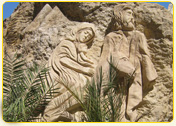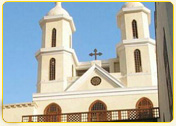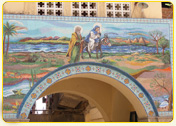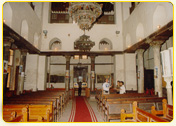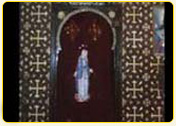Special Services - Holy Family
The Egyptian Church in coordination with Ministry of Tourism identified 22 areas that represent the Holy Family drive in Egypt. This decision was taken to start developing and beautifying these areas in preparation for the world celebration in which major European tourist companies are to participate in the year 2000.
These areas include El-Zaranik and Al-Farma natural preserves in Sinai, in addition to Tal Basta, Samanoud, Sakara, Natroun Valley, Garnous Monastry in Magaga, Bahnasa, Birds Mountain (Samalout), Ain Shams, Old Egypt and Zaitoun. It is decided, however, that Egyptian Church coordinates with a number of other organs with a view to taking all measures required to facilitate visits to be paid by tourist groups.
The beginning of June (24 Bashance in the Coptic calendar) marks the anniversary of the Holy Family’s historical journey through Egypt.
The journey was started by the Holy Family, including Joseph the carpenter, the Virgin Mary and her Child; the Christ, in fulfillment of the Divine Order to leave Palestine for Egypt, the land of safety and security. According to Matthew, “Now when they had departed, behold an angel of the Lord appeared to Joseph in a dream and said ‘Rise, take the child and his mother, and flee to Egypt, and remain there until I tell you.’ Matthew 2- 13.
The Holy Family passed by me than 20 cities on their way through Sinai, Gaza, Al-Arish and Al-Farama to the east, to Sakha in the west, and Assuit in Upper Egypt.
The journey started when the Holy Family moved from Bethlehem to Gaza where they took the old coastal road to Al-Arish and 37 km west of Al-Arish to the ancient town of El-Flusiat presently known as Al-Zaranik reserve. Three ancient churches, dating back to the fifth or the sixth century have been recently discovered in this area, where excavations are still going on.
The Family continued their journey along the coastal road to El-Farama, which was in the past the Forefront City on the old borders of Egypt, surrounded by high walls. Then, they moved to Tal Basta where the Christ felt thirsty. Thereupon, a spring of water burst out in the area wherefrom he drank. They left Tal Basta to Samanood, then called Meniat Nagah where they were warmly welcomed. In return, the Christ blessed them and said to his mother the Virgin Mary, “There will be in this place a church that will be named after you.”
The remains of this ancient church are under the existing church now known as the Virgin and the Martyr Abanoob Church.
The Holy Family moved from Samanood to Sakha in the middle of Delta, near Kafr El-Sheikh. There, the Christ set his foot on a stone and the print appeared on it. The stone showed traces of oil used for treatment. Then, the Holy Family visited the area of Saint Demiana monastery.
From Sakha to Natroun valley where the Christ blessed the area and said to his mother the Virgin Mary: “Many of the virginal monks who, like you, worship the Lord as angels, will live in this desert and adore God as angels do.” There, the well-known monasteries of Natroun valley were established, i.e. El-Baramos, El-Serian, Abu Maqqar and the most famous monastery Anba Bishowy monastery where the papal headquarter of the Copts is based.
The Holy Family proceeded towards Upper Egypt. According to the ancient Greek manuscripts, the Holy Family passed by Memphis the ancient capital of Egypt. Recently, the remains of Anba Armia’s monastery have been discovered beside the pyramid of Onas in Saqqara area. Moses monuments occupy most of the Coptic museum halls.
At Samalout, Menia Governorate, the Holy Family crossed the Nile where they visited AI-Tair area, famous for its caves, and settled in one of these caves that exist now in the existing church lying on the mountain. This church contains many Coptic monuments around the entrance and the upper floor.
According to Coptic history, the Christ’s palm print appears on a part of the mountain. It is said that as the mountain was about to fall down on the Holy Family, the Christ stretched out his hand to keep it from falling, leaving there his palm print. That was why it was called the Palm Mountain.
The Ashmons was one of the famous episcopates in Upper Egypt, where the greatest cross-shaped basilicas were found. It is said that at the town center there were high pillars on top of which there was a cock that crows each time a stranger entered the town. The Family stayed in the area of Al-Moharraq monastery built in the fourth century AD for sixth months and ten days. That was the longest period that the Holy family spent in one place in Egypt.
That monastery was called Al-Moharraq because water did not reach it in view of its height. In this place the Holy Family received the Divine Command to return back to Palestine.
On the way back to Palestine, the Holy Family arrived in Assuit and the area of Drunka Mountain, where they took a boat to Memphis. In the Nile water at this spot, a Bible was found open on a verse saying: “God Bless the People of Egypt”.
The church of the two Martyrs Sergius and Wadhi is considered one of the most important places of Ancient Egypt visited by the Holy Family. According to ancient history, the cave under the altar dates back to the visit. There are many icons and ancient Coptic monumental wood in this church.
While the Holy Family was passing by the Oon temple in Ain Shams, (Cairo) according to the Coptic tradition, the idols fell down there and nothing remains of the sun-worship Oon temple but the famous Ain Shams obelisk. “The Tree of the Virgin” at Matariya where the Holy Family visited and stayed under its shadow, still survives as one of the most important historical places in Cairo.
The historical journey of the Holy Family lasted for more than three years and a half. Jesus Christ came to the land of Egypt in fulfillment of a Divine Command waiting to honour his message. He blessed the land and drank from the water of the Nile. Every year the Coptic Church celebrates the anniversary of this journey and the Christ’s arrival to Egypt.
